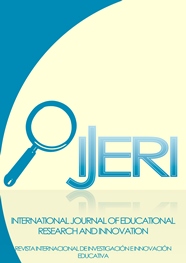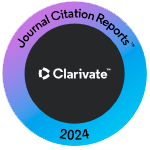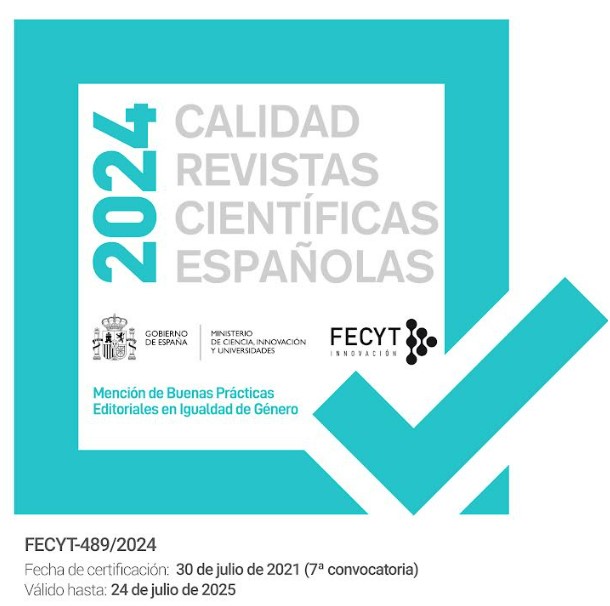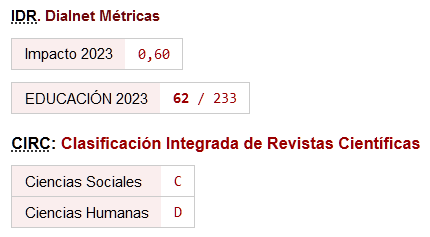¿Qué enseña la literatura sobre patología digital? Un estudio bibliométrico en Web of Science.
DOI:
https://doi.org/10.46661/ijeri.4918Palabras clave:
análisis bibliométrico, patología digital, mapeo científico, producción científica, Web of ScienceResumen
La patología digital (DIPA) se ha convertido en una disciplina efectiva que genera un entorno gráfico para diagnosticar e interpretar la información patológica de las personas. Al analizar la literatura existente sobre DIPA, se produjo una brecha de conocimiento al no informar un estudio que ha analizado bibliométricamente las publicaciones sobre el tema. El objetivo de este estudio es analizar la producción científica y el rendimiento alcanzado por el término patología digital en la base de datos de Web of Science (WoS). Para ello, se ha llevado a cabo una metodología basada en la bibliometría, complementada con la técnica de mapeo científico para buscar, registrar, analizar y predecir la literatura científica sobre el estado de la cuestión. Hemos trabajado con una unidad de análisis de 1222 documentos reportados desde la base de datos de WoS. Los resultados muestran que no hay un tema de investigación en el campo de estudio de DIPA que se destaque del resto. Se puede observar una brecha conceptual en el desarrollo temático, dado que no hay un tema que se repita en todos los periodos, donde las conexiones son más temáticas que conceptuales. Hay documentos clave para diferentes temas. Los temas principales han sido muy diferentes a lo largo de los años como la telepatología y la inteligencia artificial.
Descargas
Citas
Begley, C.G., & Ellis, L.M. (2012). Raise standards for preclinical cancer research. Nature, 483, 531–533.
Benke, K., & Benke, G. (2018). Artificial Intelligence and Big Data in Public Health. International Journal of Environmental Research and Public Health, 15(12), 1-9. http://doi.org/10.3390/ijerph15122796
Bizzego, A., Bussola, N., Chierici, M., Maggio, V., Francescatto, M., Cima, L… Furlanello, C. (2019). Evaluating reproducibility of AI algorithms in digital pathology with DAPPER. PLoS computational biology, 15(3), 1-24. https://doi.org/10.1371/journal.pcbi.1006269
Corredor, G., Whitney, J., Arias, V., Madabhushi, A., & Romero, E. (2017). Training a cell-level classifier for detecting basal-cell carcinoma by combining human visual attention maps with low-level handcrafted features. Journal of Medical Imaging, 4(2), 1-15. https://doi.org/10.1117/1.JMI.4.2.021105
Fauzi, M.F.A., Chen, W., Knight, D., Hampel, H., Frankel, W.L., & Gurcan, M.N. (2019). Tumor Budding Detection System in Whole Slide Pathology Images. Journal of Medical System, 44(38), 1-10.
Holliday, D.L., & Speirs, V. (2011). Choosing the right cell line for breast cancer research. Breast Cancer Research, 13(4), 1-7. https://doi.org/10.1186/bcr2889
Hsieh, W.-H., Chiu, W.-T., Lee, Y.-S., & Ho, Y.-S. (2004). Bibliometric analysis of Patent Ductus Arteriosus treatments. Scientometrics, 60, 105–215.
Klimov, S., Miligy, I.M., Gertych, A., Jiang, Y., Toss, M.S., Rida, P… Aneja, R. (2019) A whole slide image-based machine learning approach to predict ductal carcinoma in situ (DCIS) recurrence risk. Breast Cancer Research, 21(1), 1-19. https://doi.org/10.1186/s13058-019-1165-5
López-Belmonte, J., Segura-Robles, A., Moreno-Guerrero, A.J., & Parra-González, M.E. (2020). Machine Learning and Big Data in the Impact Literature. A Bibliometric Review with Scientific Mapping in Web of Science. Symmetry, 12(2), 1-15. https://doi.org/10.3390/sym12040495
López-Belmonte, J., Moreno-Guerrero, A.J., López-Núñez, J.A., & Pozo-Sánchez, S. (2019). Analysis of the Productive, Structural, and Dynamic Development of Augmented Reality in Higher Education Research on the Web of Science. Applied Science, 9(24), 1-21. https://doi.org/10.3390/app9245306
Lugli, A., Kirsch, R., Ajioka, Y., Bosman, F., Cathomas, G., Dawson, H… Quirke, P. (2017). Recommendations for reporting tumor budding in colorectal cancer based on the International Tumor Budding Consensus Conference (ITBCC) 2016. Modern Pathology, 30(9), 1299–1311. https://doi.org/10.1038/modpathol.2017.46
Majo, J., Klinkhammer, B.M., Boor, P., & Tiniakos, D. (2019). Pathology and natural history of organ fibrosis. Current Opinion in Pharmacology, 49, 82-89. https://doi.org/10.1016/j.coph.2019.09.009
Moreno-Guerrero, A.J., Gómez-García, G., López-Belmonte, J., & Rodríguez-Jiménez, C. (2020). Internet Addiction in the Web of Science Database: A Review of the Literature with Scientific Mapping. International Journal of Environmental Research and Public Health, 17(8), 1-17. https://doi.org/10.3390/ijerph17082753
Mukundan, R. (2019). Analysis of Image Feature Characteristics for Automated Scoring of HER2 in Histology Slides. Journal of Imaging, 5(3), 1-12. https://doi.org/10.3390/jimaging5030035
Naylor, P., Laé, M., Reyal, F., & Walter, T. (2018). Segmentation of nuclei in histopathology images by deep regression of the distance map. IEEE transactions on medical imaging, 38(2), 448-459. https://doi.org/10.1109/TMI.2018.2865709
Norazman, S.H.B., Nakamura, T., Kimura, F., & Yamaguchi, M. (2019). Analysis of quantitative phase obtained by digital holography on H&E-stained pathological samples. Artificial Life and Robotics, 24(1), 38-43. https://doi.org/10.1007/s10015-018-0468-4
Patra, S.K., Bhattacharya, P., & Verma, N. (2006). Bibliometric Study of Literature on Bibliometrics. DESIDOC Journal of Library & Information Technology, 26(1), 27–32. https://doi.org/10.14429/djlit.26.1.3672
Rodríguez-García, A.M., López-Belmonte, J., Agreda, M., & Moreno-Guerrero, A.J. (2019) Productive, Structural and Dynamic Study of the Concept of Sustainability in the Educational Field. Sustainability, 11(20), 1-12. https://doi.org/10.3390/su11205613
Saxena, P., & Goyal, A. (2019). Study of Computerized Segmentation & Classification Techniques: An Application to Histopathological Imagery. Journal of Computing and Informatics, 43(4), 561-572. https://doi.org/10.31449/inf.v43i4.2142
Tavolara, T.E., Khan, M.K., Arole, V., Chen, W., Frankel, W., & Gurcan, M.N. (2019) A modular cGAN classification framework: Application to colorectal tumor detection. Scientific Reports, 9, 1-8.
Williams, B.J., Bottoms, D., Clark, D., & Treanor, D. (2019). Future-proofing pathology part 2: building a business case for digital pathology. Journal of clinical pathology, 72(3), 198-205. https://doi.org/10.1136/jclinpath-2017-204926
Zaidi, M., Fu, F., Cojocari, D., McKee, T.D., & Wouter, B.G. (2019). Quantitative Visualization of Hypoxia and Proliferation Gradients Within Histological Tissue Sections. Frontiers in Bioengineering and Biotechnology, 7, 1-9. https://doi.org/10.3389/fbioe.2019.00397
Zwanenburg, A., Vallières, M., Abdalah, M.A., Aerts, H.J.W.L., Andrearczyk, V., Ashrafinia, S…, Löck, S. (2020) The Image Biomarker Standardization Initiative: Standardized Quantitative Radiomics for High-Throughput Image-based Phenotyping. Radiology, 295(2), 1-16. https://doi.org/10.1148/radiol.2020191145
Descargas
Publicado
Cómo citar
Número
Sección
Licencia
Derechos de autor 2021 Jesús López-Belmonte, Adrián Segura-Robles, William C. Cho, María-Elena Parra-González, Antonio-José Moreno-Guerrero

Esta obra está bajo una licencia internacional Creative Commons Atribución-NoComercial-SinDerivadas 4.0.












